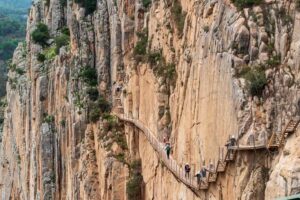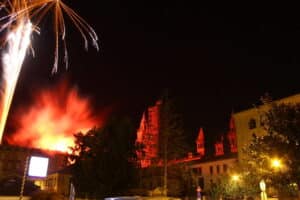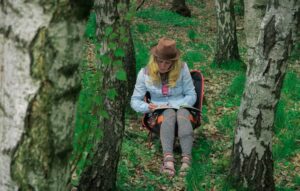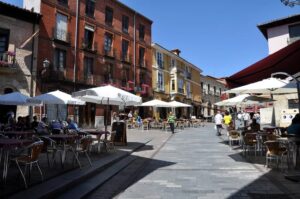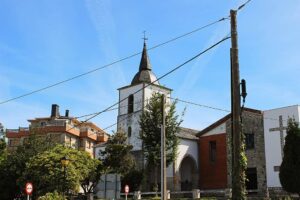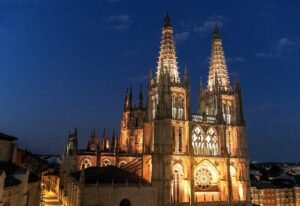Pola de Allande is a charming village located in the western part of Asturias, along the Camino Primitivo. This place is surrounded by mountains and lush green landscapes, known for its natural beauty and rich historical and cultural heritage.
As the capital of the Allande municipality, it has been a key reference point for the region for centuries. It stands out for its traditional Asturian architecture and historic monuments, which we will discuss below.
This combination of heritage, nature, and spirituality makes Pola de Allande an intriguing destination for all pilgrims. Want to learn more? Enjoy the journey!
Índice de contenidos
Pola de Allande and the Camino de Santiago
This is a must-stop on the Camino Primitivo, considered the oldest route to Santiago de Compostela. To explore it further, we suggest seeking the help of a specialised travel agency for the Camino de Santiago.
This stage is one of the most emblematic, not only for its natural beauty but also for the rich history that surrounds it.
This path, which stretches through mountains and untouched landscapes, is famous for its authenticity. This village is strategically located on a stage that precedes the Alto del Palo, one of the most significant challenges of this route.
Moreover, it offers a more introspective and less commercialised experience than other routes, such as the Portuguese Coastal Camino, the Camino de Santiago from Baiona or the Camino de Santiago from Ferrol.
The influence of the Camino Primitivo in Pola de Allande is evident. The village has not only grown around this historic route but has also developed an infrastructure to cater to walkers.
Local support is apparent in the hospitality of its residents and the availability of useful information about different routes, such as the Camino de Santiago from Roncesvalles or the Portuguese Coastal Camino. Yes, these are also popular options for pilgrims who want to explore different parts of the Camino network.
Pola de Allande’s Historic Centre
Pola de Allande’s historic centre is a charming reflection of traditional Asturian architecture and lifestyle.
Strolling through its cobbled streets is like travelling back in time, where you can appreciate the well-preserved historic buildings and the urban layout that has maintained its essence for centuries. The stone houses, with wooden balconies and slate roofs, are characteristic of the local architecture and line the narrow streets, inviting you to explore them on foot.
Some of the most notable places include:
- The Town Hall, a classic-style building that serves as the administrative and social heart of the town.
- Another point of interest is the Church of San Andrés, a Gothic-style structure that has been restored over the years. In fact, it retains Romanesque elements in its architecture, offering a glimpse into the religious history of the region.
- Additionally, the manor houses scattered throughout the centre demonstrate the importance of this village as a centre of power and wealth in past centuries.
Furthermore, the local atmosphere is warm and welcoming, reflecting the hospitable nature of its inhabitants. Small shops offering local products, from cheeses and sausages to traditional crafts, are interspersed with cafés and bars where you can enjoy a coffee or cider in a relaxed setting.
Nature and Hiking Trails in Pola de Allande
This region offers a perfect setting for those seeking to connect with nature and enjoy breathtaking landscapes. The oak and chestnut forests, along with the pastures and hills, create a mosaic of colours that changes with each season, providing visitors with a constantly renewed experience.
For hiking enthusiasts, Pola de Allande offers several recommended hiking routes that allow you to explore these natural landscapes in all their glory.
- One of the most popular routes is the Palaces Route, which takes you through some of the most prominent manor houses in the area, combining history and nature in one journey. This route allows you to enjoy a leisurely walk along well-marked paths while admiring the traditional architecture and gardens surrounding these old residences.
- Another must-see option is the Montefurado Route, a trail that leads hikers through mountainous paths to reach an ancient Roman tunnel that cuts through the mountain. This tunnel, created to divert the river’s course and facilitate gold extraction, is a fascinating blend of history and adventure.
- Lastly, the route to Peña Negra is ideal for those seeking a greater challenge. This hike, which ascends one of the highest peaks in the area, rewards hikers with spectacular views stretching for miles.
Historical and Cultural Monuments
Pola de Allande has numerous historical monuments that are worth visiting, each telling a story of its past and contributing to the identity of the village.
Among them, the Cienfuegos Palace stands out. This majestic building, with its powerful presence, has been the residence of one of the most influential families in the region since the 15th century.
This palace, built in the late Gothic style, has a square tower and a fortified enclosure that protected the noble family from potential attacks. Over time, it was expanded and renovated, adding Renaissance elements that enhanced its architectural beauty.
It is currently a private residence, but it remains an iconic image of the town and can be admired from the outside.
In addition, the Chapel of San Juan, located a short distance from the village, is another architectural jewel that bears witness to Pola de Allande’s religious and cultural history. This small chapel, with its simple design, has a special significance for the local community, which celebrates its patron saint’s day every year.
In summary, Pola de Allande is an exceptional place, offering a unique combination of history, culture, nature, and the Camino de Santiago. We hope you found this guide helpful and that you are now ready to enjoy this beautiful destination. Safe travels!

